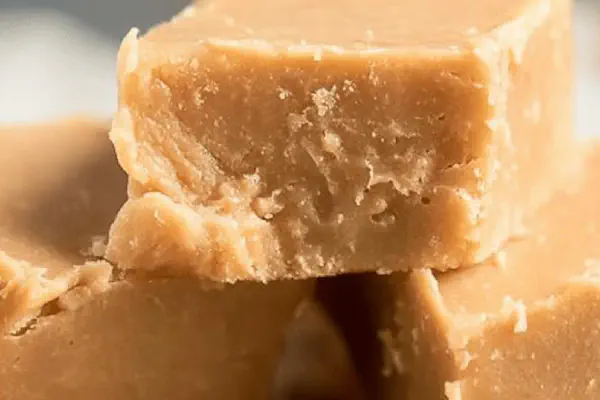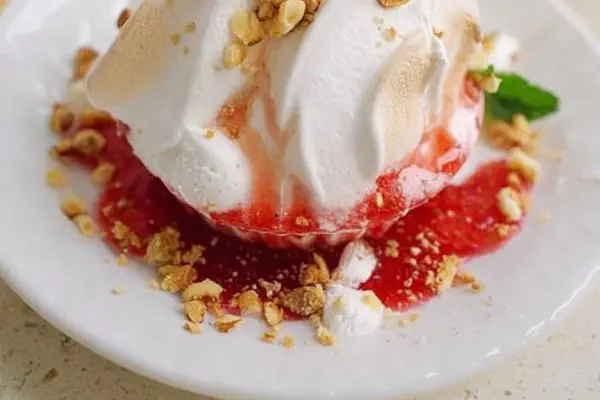Old-School Peanut Butter Fudge

By Emma
Certified Culinary Professional
Ingredients
- 1 stir butter
- 1 cup white sugar (swap half for brown for molasses twist)
- 1 cup light corn syrup
- 1 cup whole milk (cream for richer, evaporated for deeper flavor)
- 1 cup creamy peanut butter (chunky adds texture punch)
- 2 cups mini marshmallows (use larger marshmallows chopped if none)
- Butter for greasing pan (parchment paper lining for no-stick)
About the ingredients
Method
- Start with sugars, butter, and milk in heavy pot. Melt over medium heat, stirring to combine. Sound changes from splash to steady bubbles. Using candy thermometer, watch for 236 degrees Fahrenheit, soft ball stage; this gives fudge its chew. Don’t wander — overshoot means grainy mess.
- Remove pot from heat, dump in peanut butter and marshmallows. They'll melt confusingly but keep at it. Whip with hand mixer or sturdy spoon until mixture thickens noticeably; becomes more matte, not shiny. That's fudge’s body building. Too thin, fudge won’t set right.
- Pour thick mix into buttered or parchment-lined 8x8 pan. Use spatula to scrape sides; no fudge left behind. Smooth top if you care. The heat lingering here is crucial; avoid jiggling pan — fudge still settling its secrets.
- Leave pan on countertop out of draft. Cooling takes about 1 hour 45 minutes to 2 hours; fudge hardens to firm but not rock. A good test: lightly touch edge, slight give but no sticky residue. Slice into squares once fully cooled to room temp.
- Extra tip: If fudge fails to set, warm slightly and add more peanut butter to increase fat content or stir in crushed nuts for texture fix. Moisture from humid kitchens can slow setting; chill briefly if anxious but beware condensation.
Cooking tips
Chef's notes
- 💡 Butter controls fudge softness. Swap white sugar half with brown sugar for molasses notes and moisture. Milk type changes final texture; cream thickens, evaporated adds depth but slows setting. Chunky peanut butter shifts bite; creamy melts smoother. Minis melt evenly; large marshmallows chop fine if desperate. Always grease or parchment pan; parchment eases removal, less stress.
- 💡 Watching sugar boil? Listen for splash then steady bubbles. Avoid just eyeballing color or size; thermometer at 236 F means soft ball. Overshoot means grainy fudge mess. Once heat stops, adding peanut butter and marshmallows fast is key. Melting stage tricky—sticky, confusing, patience needed. Whip 'til mix loses shine and thickens; matte texture signals fudge forming.
- 💡 Pour mixture fast into pan but scrape sides fully. Leftover crumbs risk uneven texture. Smooth top if you must but avoid disturbing heat too much. Leave pan out of drafts on countertop. Cooling slow, about 1 hour 45 min to 2 hours. Patience here pays; fridge condensation ruins fudge’s texture, makes sticky mess. Test edges with finger; slight give means good set.
- 💡 If fudge won’t set, warm gently and add more peanut butter or crushed nuts. Fat increases firmness; nuts add texture. Moisture from humid kitchens delays setting. Adding coconut milk swaps flavor completely—expect longer set times. Adjust recipe carefully; sugar, fat, moisture balance crucial. Cooking fudge involves chemistry, not guesswork. Measure and watch closely.
- 💡 Whipping is tough step. Mix stiffens from shiny to dull—skip or underdo, won’t hold shape or texture. Use hand mixer or sturdy spoon. Arm tires but payoff is fudge’s bite. Cooling must be undisturbed. Slice only once fully cooled; warm fudge sticks to knife leaving messy cuts. Use spatula to scrape pan edges when pouring; helps avoid crumb pockets.
Common questions
How to know sugar reached soft ball stage?
Watch bubbles change from splash to steady. Thermometer reads 236 F. Without tools, pinch test in cold water but less reliable. Visual cues tricky. Listen for quieting boil.
Can I use chunky peanut butter?
Chunky adds texture punch, changes bite. Melt time same but fudge slightly chunkier. Sometimes mix harder to stir. Adjust whipping time. Use creamy if want smooth texture.
Why doesn’t fudge set right?
Overcooked sugar makes grainy fudge, undercooked stays too soft. Not whipping enough means no structure. Humidity can prevent setting; fridge helps briefly but causes condensation mess. Add peanut butter or nuts to fix softness sometimes.
Best storage for fudge?
Wrap airtight room temp 1 week fine. Fridge extends but risks moisture condensation; wrap tight. Freeze? Yes but texture may change; thaw slowly. Avoid direct air exposure; fudge hardens and dries out.



